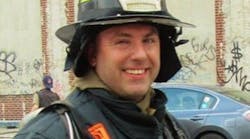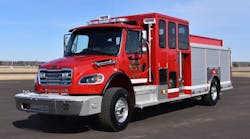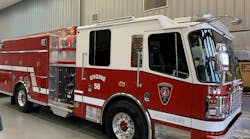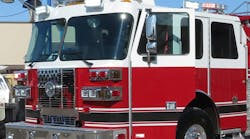On April 1, 2001, a ladder truck, third due to a dumpster fire, traveled through a traffic-controlled intersection against a red light and slammed into an SUV, causing profound and permanent injuries to the civilian driver. The jury awarded over $15 million to the driver of the SUV as the result of the negligence of the driver of the ladder truck, the officer in charge and the fire district.
So ruled a jury after a "trial" in a Baltimore "courtroom" in July 2006.
The facts developed at the "trial" showed that the ladder truck was the third-due apparatus to a dumpster fire at the local recycling center. Initial dispatch information indicated that there were no exposures or special hazards. The fire was controlled quickly by the first-arriving engine company and department chief. Unfortunately, the ladder truck continued toward the scene in an emergency operation mode (lights and sirens), including traveling through an intersection controlled by a traffic signal. The eyewitness and other testimony revealed undisputed evidence that the ladder truck entered the intersection against a steady red traffic signal and proceeded to collide with an SUV. The accident caused debilitating injuries to the driver of the civilian vehicle, including a traumatic brain injury that prevented her from returning to her occupation as a physician.
The fire district, despite repeated efforts by its training officer to implement a downgraded response policy that had been rejected by the district, was found equally liable following a "trial" that included descriptions of training lapses, incomplete and false training records and failure to follow established department standard operating procedures (SOPs) for vehicle response. The driver and department chief were also named as defendants.
So went a mock trial held during Firehouse Expo 2006 in a classroom at the Baltimore Convention Center. The lawyers, witnesses and participants wove a realistic portrayal of a horrible accident that resulted from the combined effects of the failure to follow established SOPs, "paper" training and the failure to follow the recommendations of the department's training officer. Following the trial, a jury found that the actions of the fire district, the chief of the department and the apparatus operator constituted negligence and awarded $15 million in damages.
The jury was composed of audience volunteers, selected as the classroom filled. I played the role of lawyer for the plaintiff, played by Snyder, NY, Firefighter/EMT Paula Radel, who is a New York State-certified fire instructor. The ladder truck operator, played by author and apparatus operations expert Michael Wilbur, was shown to have gone through a red traffic light at an intersection without stopping, despite a fire district SOP requiring a full stop at all intersections and treating each lane of traffic as a separate intersection.
Under withering cross examination, the apparatus operator acknowledged that he failed to stop at the intersection, much less slowing, and that he never saw the vehicle operated by the plaintiff until just before the collision. The apparatus operator's company officer, portrayed by retired Lieutenant Charles Kortlang, a Mount Vernon, NY, municipal training officer, admitted in his testimony that he had not conducted the required twice-annual driver training refresher with the apparatus driver, "because he was a professional and he has a CDL (commercial driver's license)."
Despite valiant efforts by defense attorney Melissa Fingar, an attorney who represents emergency service agencies at the Rochester, NY, law firm of Harris Beach, PLLC, to show that the driver of the other vehicle was impaired, the jury determined that the actions of the apparatus operator and fire district justified the $15 million award.
The jurors, when interviewed after the mock trial, indicated that the refusal of the fire district to implement the policy of downgraded responses when no true emergency exists (when the immediate situation, the dumpster fire, was apparently under control), despite several recommendations by the fire department's training officer, played by Williamsville, NY, Fire Department Assistant Chief (and certified fire instructor) Thomas Ratzel, was a key factor in establishing liability.
The mock trial also showed the powerful impact of expert-witness testimony, including that of an accident-reconstruction expert, who demonstrated the scientific certainty of speed determination at the time of impact from evidence obtained at the scene after the accident. The accident reconstructionist was played by nationally certified fire instructor John V. Fildes, a retired senior accident investigator for the Amherst, NY, Police Department.
Retired Ithaca, NY, Fire Chief Edward Olmstead (also a nationally certified fire instructor) played the expert witness on fire department operations, citing several National Fire Protection Association (NFPA) and other standards to establish that the actions of the fire chief and fire district fell below the standard of care expected in the fire service.
The testimony of the driver and the company officer showed that, while the ladder driver had an otherwise unblemished record to that point, that he did not follow department SOPs requiring full stops at all controlled intersections (against the control) prior to entering the intersection. It was also shown that the company officer failed to conduct twice-annual driver refresher training, yet submitted training paperwork stating that it had been completed.
The fire chief testified further that he had repeatedly submitted training and operational suggestions to the Board of Fire Commissioners, including a protocol for a downgraded response when no true life emergency existed. The fire commissioner testified that the board refused to implement the proposals, because it could affect recruitment and retention if members "couldn't use lights and sirens."
Following the trial, the jurors (who had been selected randomly from the audience) were polled for their verdict; the jury unanimously found for the plaintiff and awarded $15 million in damages. Wilbur then conducted an evaluation of the several legal and operational issues raised by the trial, including the culpability of not only the authority having jurisdiction for its actions (and failures to act), but also the failures of the officers and drivers to follow training and operational guidelines.
While the trial and courtroom were fictional, the potential reality of the circumstances left the attendees with a greater appreciation for the need for good training, sound education and effective leadership.
The author expresses appreciation for all who assisted with the mock trial, including the bystander witnesses played by Sue Olmstead and Betty Kortlang; Firehouse® Contributing Editor Tom Shand, who acted as the mock trial judge; Chief Fred Theadore of the Circleville, NY, Fire Department; Commissioner John Horan of the Circleville, NY, Fire District; and the members of the audience who acted as jurors.
Michael Wilbur adds: I would like to thank Mark Butler for writing this recap of the mock trial at my request.
Although it was a mock trial, I can tell you it felt very real, as I sat in the defendant's chair sweating and feeling sick. As a defendant, you cannot say or do anything as the prosecution presents its case. Many times, I wanted to say something to the prosecution in rebuttal, but I could not. Honestly, it was the most helpless that I have ever felt in my life. As the defendant, it was equally frustrating to be allowed to answer only the questions asked of me. I had much more information that would have been helpful in my defense, but I could answer questions only in the narrowest of ways. Yes, this was a mock trial, but from my perspective, it sure did not feel that way.
One important teaching point was the "paper" training, as Mark referred to it. How many fire departments, fire officers, training officers or others are signing off on training that never occurred or that did not occur as it was written in the training report? This is dangerous, as ultimately they will be found out and could pay a horrible price.
I had no idea how badly the deck would be stacked against me. I knew that there would be accident reconstructionists and other experts. However, when my own training officer took the stand and started to testify against me, I knew all was lost; from an emotional standpoint, I was devastated to think that a brother firefighter would testify against me. As firefighters, we believe that as bad as anything gets, we still have the support of our brother and sister firefighters, but in the mock trial that simply was not the case.
Again, I would like to thank Mark Butler and all of the participants in the mock trial for not only taking part in it, but the way you all worked so hard to make it feel and look very real. It is a credit to your professionalism and your dedication to safety in the fire service.
MARK BUTLER, who portrayed the plaintiff's lawyer in this mock trial, is a Buffalo, NY-based volunteer firefighter, New York State-certified fire instructor and attorney who represents fire departments, fire districts and municipalities regarding fire and emergency services.





